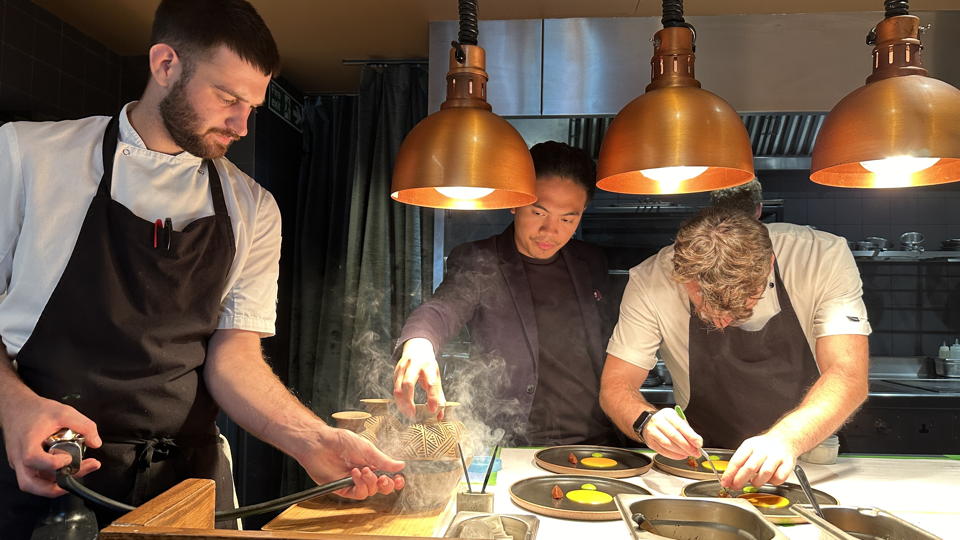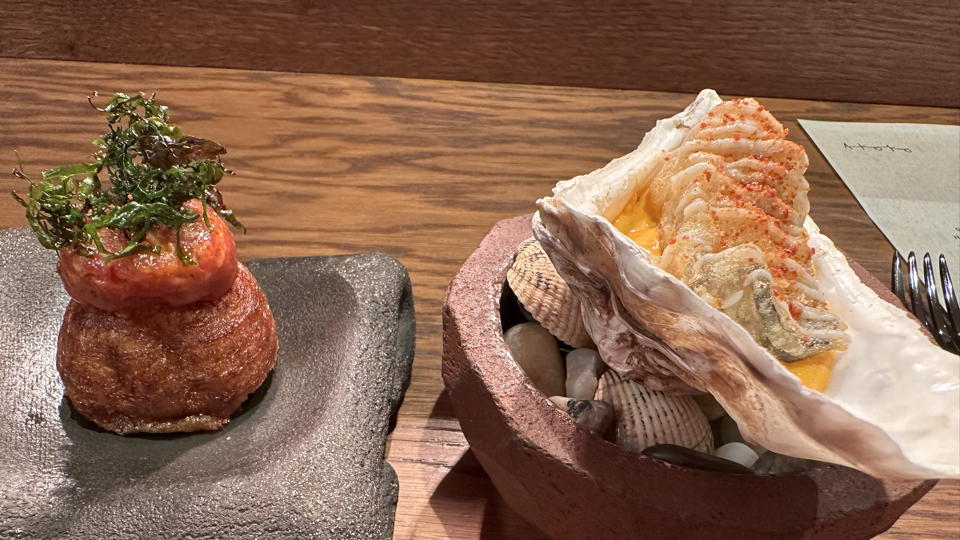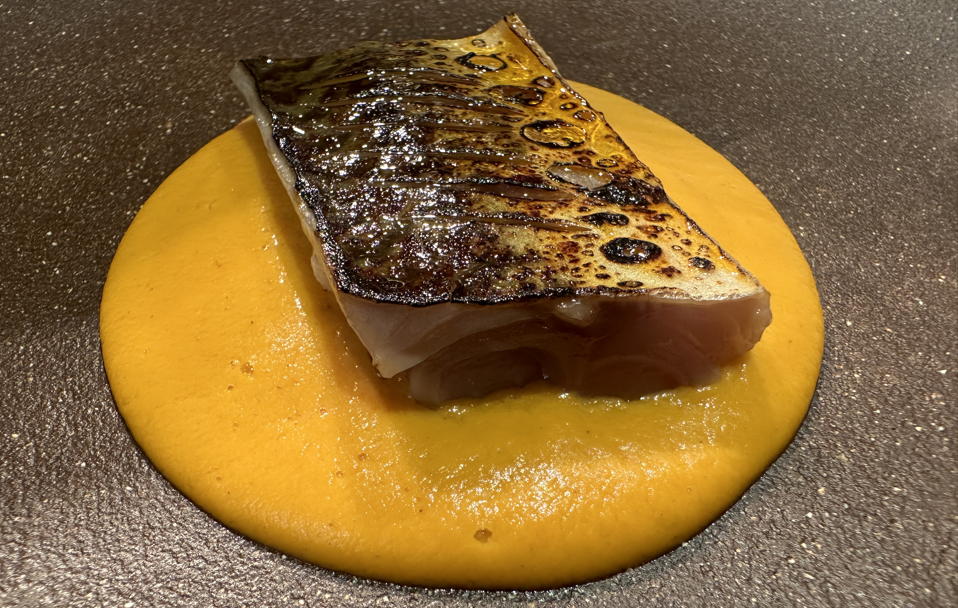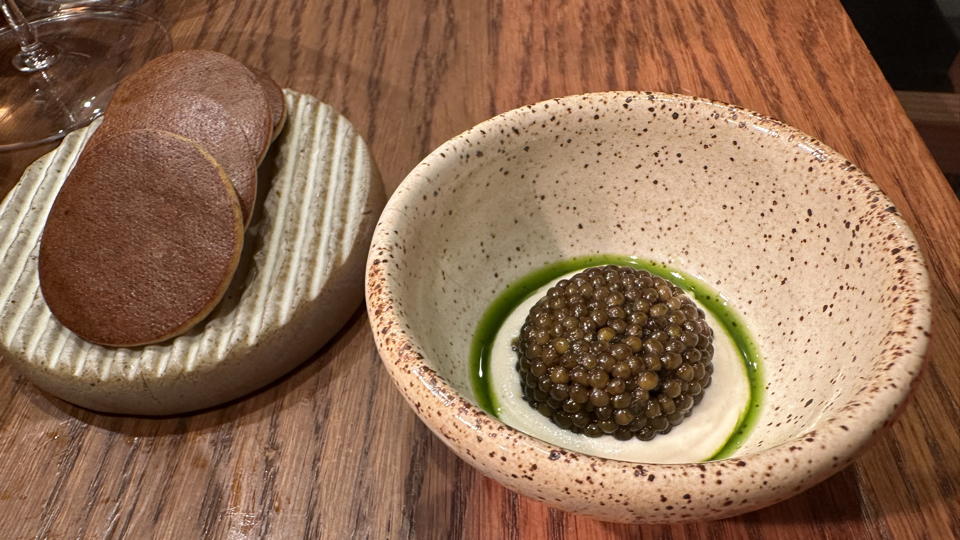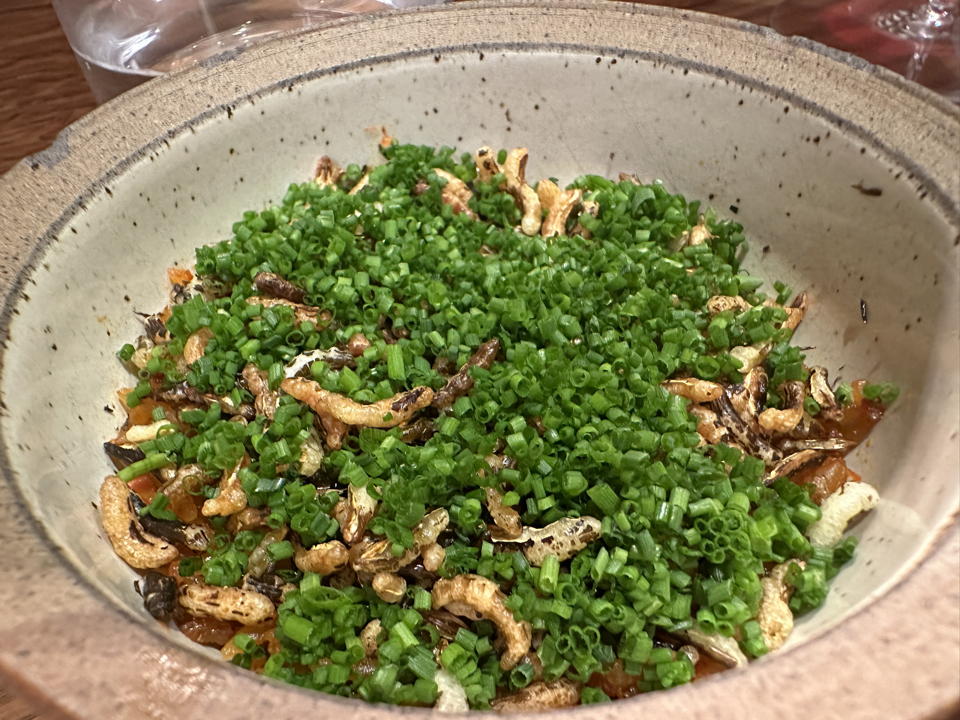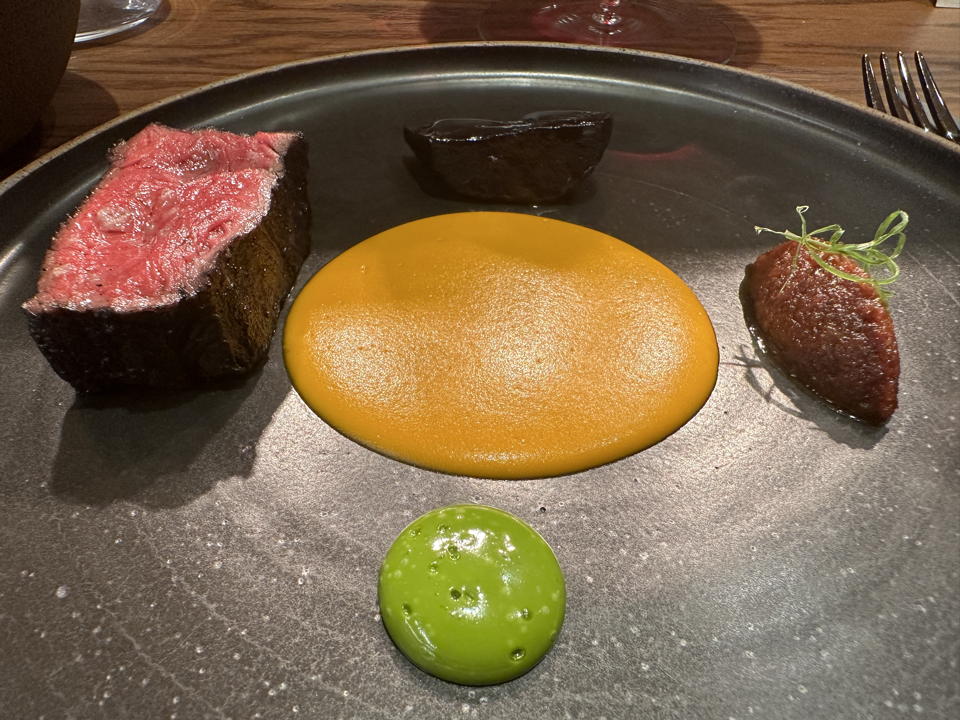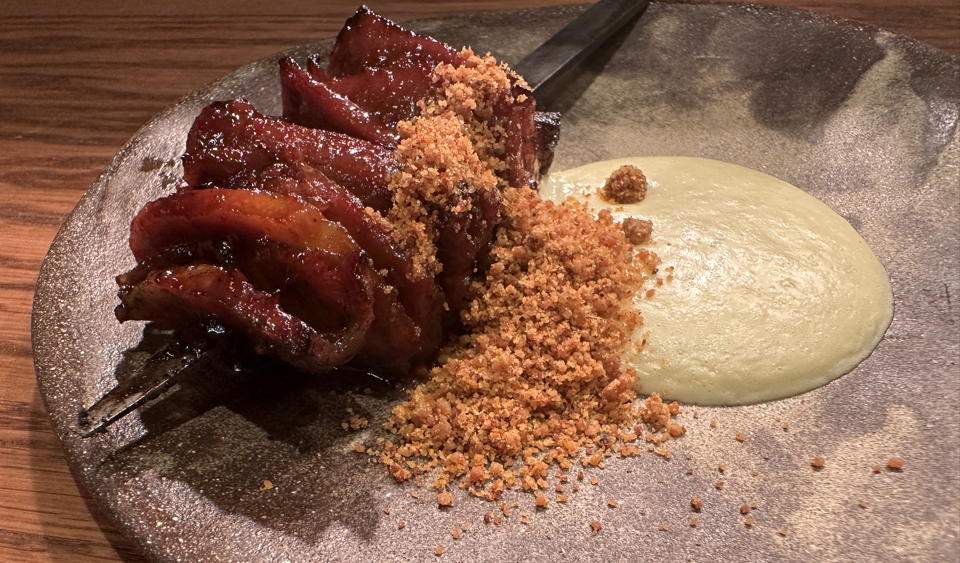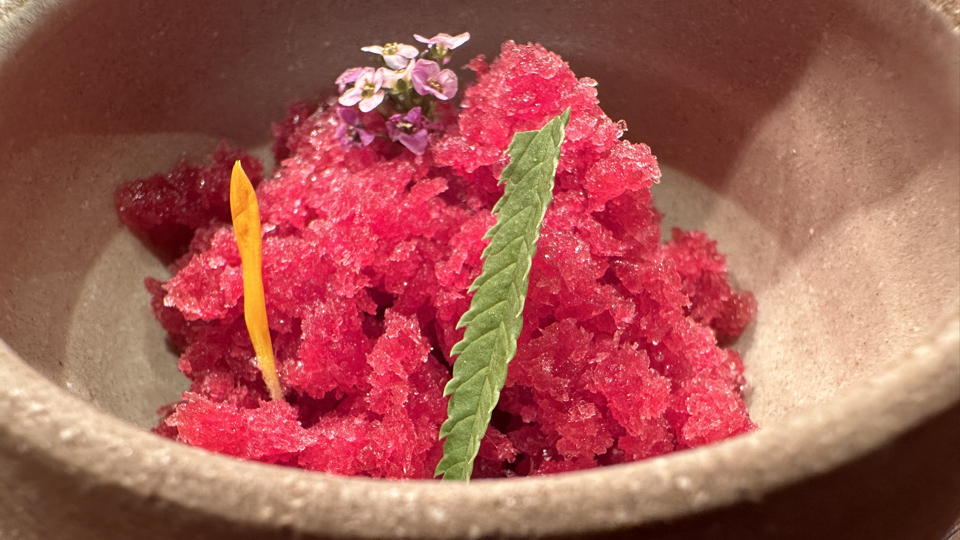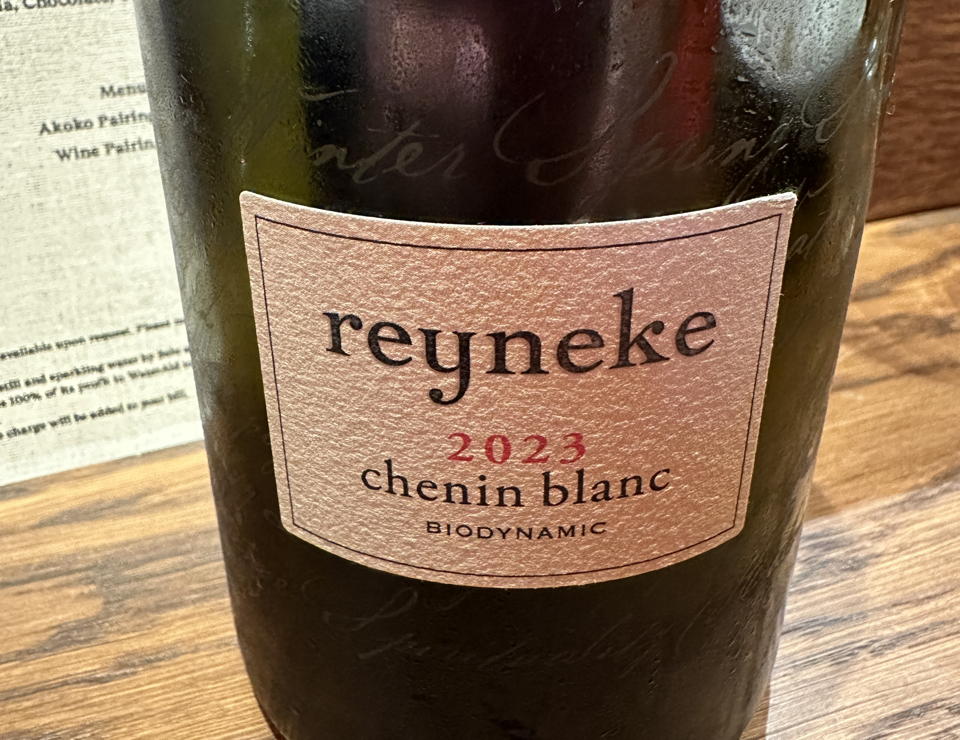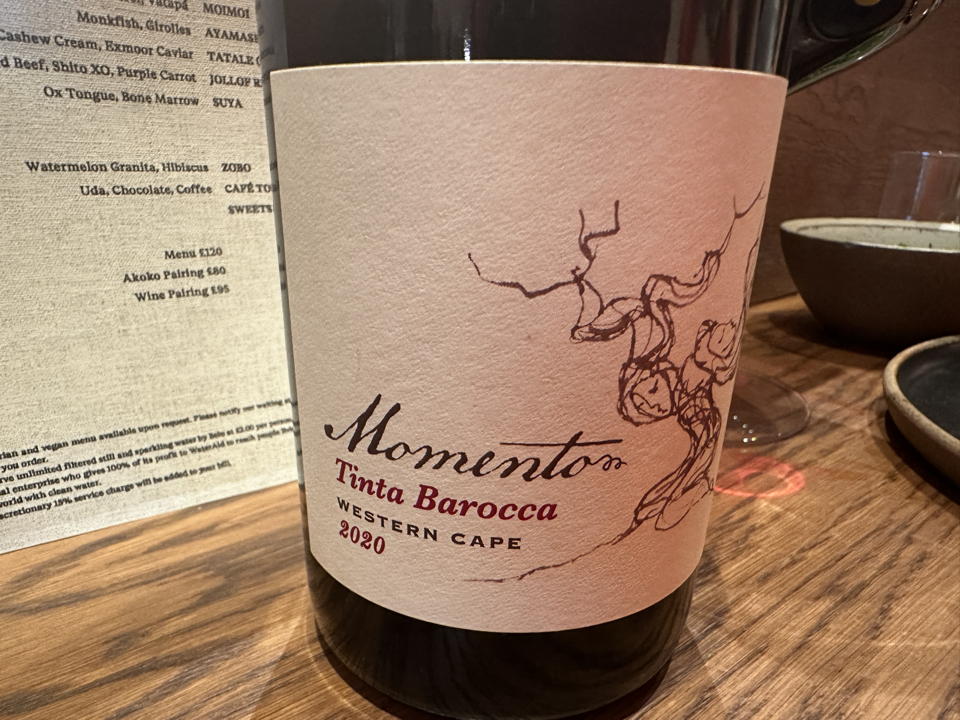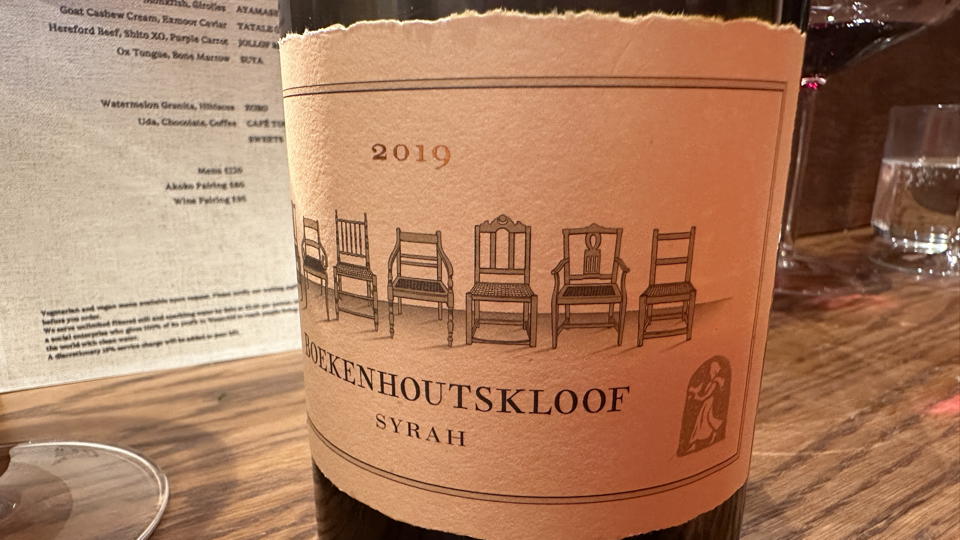Browse using the new Vinous website now. Launch →
Printed by, and for the sole use of . All rights reserved © 2015 Vinous Media
21 Berners St
London W1T 3LP
BY NEAL MARTIN | SEPTEMBER 27, 2024
The Food:
Plantain mosa – beef tartare, sosu kaani
Gambian stew – Irish oyster, tatase relish
Moimoi – mackerel, vatapá
Tatale – goat’s milk cashew cream and Exmoor caviar
Jollof rice – Hereford beef, Shinto XO, purple carrot
Suya – ox-tongue and bone marrow
Zobo – watermelon granita, hibiscus
Café touba – uda, chocolate, coffee
The Wines:
| 2018 Jean-Baptiste Adam Auxerrois Vieilles Vignes | 88 |
| 2023 Reyneke Wines Chenin Blanc | 93 |
| 2020 Momento Tinta Barocca | 92 |
| 2019 Boekenhoutskloof Syrah | 93 |
| 2023 Fairview Sweet Red | 89 |
There’s a buzz around West African cuisine. From its roots in London boroughs that tourist boards advise visitors to avoid, like Peckham and Brixton, West African-themed restaurants have sprouted across the capital, offering foodies a different gastronomic lexicon. Grabbing headlines is Ikoyi, which, as I wrote in my review, is more European haut cuisine with a nod to Africa and the highly touted Chishuru. Add to that list Akoko in Fitzrovia, opened by Aji Akokomi in late 2020. Nigerian-born sommelier Victor Kene recommended the restaurant when he helped with one of my tastings in Stellenbosch in July. Fired up by what I was tasting in the Cape, I booked a table upon my return.
Concentration!
Like the Tardis and some of my own articles, Akoko is larger inside than it looks from the outside. Tables are spaced widely apart. These days, I learn more about a restaurant sitting at the counter, a gastronomic voyeur, eavesdropping on kitchen chatter. The counter looks directly onto the open kitchen, which is a little “cozy” in size, causing intermittent traffic jams as waiting staff flitted in and out. It afforded me a first-hand view of the exacting approach, with every dish inspected before leaving and, on one occasion, sent back and remade.
Plantain mosa – beef tartare, sosu kaani.
Raised in Dorset by Nigerian-born parents, executive chef Ayo Adeyemi passed his culinary degree and then worked at San Francisco’s Compton Place, which melded Indian and Western dishes, inspiring him to fuse the cuisine of his African heritage in a similar fashion. Akoko’s menu celebrates dishes from Nigeria, Senegal, Gambia and Ghana using British ingredients. It won its first Michelin star this year. Based on this lunch, Akoko offers a more immersive experience of African cuisine compared to Ikoyi. Its dishes are generally spicier. Scotch Bonnet is a recurring ingredient at the heart of sauces. Rest assured, its fieriness simmers rather than burns so that it never impedes the wines. A fixed-tasting menu with vegetarian alternatives is priced at £120 per person, which is par for the course these days and is one-third of the set menu at Ikoyi. There is also a shorter lunchtime menu, but I recommend the full experience.
Moimoi cut to the nearest millimeter.
First came a pair of canapés. The plantain mosa consisted of a beef tartare with sosu kaani, a Habanero chilli sauce from Senegal. The tartare was delicious, and the sosu kaani had just the right amount of fire, looking back, the highest on the Scoville scale during the entire meal. It was twinned with Akoko’s nod to Gambian stew that traditionally uses oysters as a core ingredient. Here, the deep-fried Carlingford Irish oyster was presented in its shell and placed atop a tatashe, a red pepper relish. This combination worked extremely well, the tatashe enhancing without overwhelming the oyster’s texture or salinity.
Glistening mackerel.
Moimoi (sometimes spelled moinmoin) is a Nigerian steamed pudding based on black-eyed beans. Served alongside cured mackerel and vatapá, a South American sauce made from prawns, cashews and peppers, the fish was outstanding, oily and flavorsome. The skin was perfectly crisp and charred so that the acrid shard offset the sweetness of the vatapá. Sitting at the counter, I became mesmerized by the chef fastidiously using a metal ruler to cut the moimoi to the nearest millimeter for evening service. I asked what happened to the growing mound of offcuts. He assured me that these are reused for enhancing sauces – nothing goes to waste.
Tatale
is an additional dish to the set lunch menu.
We opted for an additional dish of Tatale. This comprised goat milk cashew cream and Exmoor caviar, plus a side of small plantain pancakes serving as blinis to scoop up the caviar. It had a satisfying freshness that was exaggerated by preceding spicier dishes. I loved the pillowy texture of the plantain. Worth an extra £35? Let’s say, enjoyable as it was, I am glad we shared.
Underneath
this surface of chives is the wonderful jollof rice.
The Jollof rice was superb. Before serving, we were presented with a booklet that explained their take. It reads: “We serve a family recipe that combines red bell peppers cooked down into a concentrate, tomatoes, pressure-cooked chicken broth, and rice toasted with spices...” Its combination of texture, flavor and spices is heavenly, and next time, I might impudently request a second bowl. Like me, you’ll want one.
A simple
but effective presentation of the Hereford beef.
Next came a prime cut of Hereford beef served with diced purple carrot and Shinto XO puree. This was fabulous. The beef was top quality with little fat, the carrot was beautifully sweet, and the puree lent a surprising Cantonese twist.
Akoko’s
suya, as delicious as it looks.
Suya, the Nigerian name for a smoked spiced meat skewer, consisted of ox tongue slow-cooked over 18 hours and seasoned with Selim pepper, with bone marrow. This was exceptionally good; the ox tongue had a melt-in-the-mouth texture and just the right amount of richness. Perhaps it overwhelmed the bone marrow a little?
The
watermelon granita is so bright that maybe they ought to serve it with
sunglasses.
The lucid bowl of Zobo comprises watermelon granita, sorrel leaf and hibiscus, which are zingy palate cleansers. The watermelon's cutting acidity was a pleasant sensation after the spices, readying the palate for the Café Touba.
Café touba – uda, chocolate, coffee
The Café
Touba included uda, a West African sweet spice, chocolate and a mousse made
from Café Touba, a Senegalese coffee bean (Touba is a city in Senegal) mixed
with clove and Selim pepper, known as djar. This was a nuanced ending to the
meal, the flavors subtle but intoxicating.
When I telephoned to confirm my booking, I asked about corkage, and they offered a reasonable £45.00, though I opted for the wine pairing menu at £95 per person since I was curious to see what they would offer. Before broaching the wines, there are two things that I must applaud. Firstly, instead of wines being cherry-picked from the list, the pairing wines are entirely different. The regular list does offer a decent selection of South African wines, though there is room to expand and be more adventurous. Also, the mark-ups are hefty even by London’s standards, a Colin-Morey Saint-Aubin En Remilly leaving little change from £500. (It’s no wonder nobody orders Burgundy in restaurants anymore.) Except for the first white, the paired wines come exclusively from the Cape and are well-chosen. Secondly, I must commend our sommelier. There’s been discussion about the decline of the “somm” both in numbers and expertise. The young woman at Akoko confessed that she was new to this game and self-effacingly rebuffed my calling her a somm. That didn’t bother me. Her enthusiasm more than compensated for her lack of knowledge, and she had an infectious, budding passion for wine. Her vinous journey is just beginning. At one point, I took out my iPhone to show her a video of the vines whose fruit produces the Chenin she was pouring. Instantly, Reyneke became more than just a name, but a real entity that she was due to visit soon.
The
first wines came not from a wine region far away from the Cape, Alsace. You
could argue that there are plenty of alternatives from the Cape to choose from.
Nevertheless, the 2018 Auxerrois Vieilles Vignes from Jean-Baptiste
Adam was a perfect foil for the spiciest dish, the moimoi. It has a fairly
neutral nose with light waxy scents. The palate is well-balanced with what felt
like a little residual sugar that was necessary just to quell the bit of fire.
It is a straightforward but perfectly enjoyable Auxerrois that should be drunk over the next two or three years. The 2023
Chenin Blanc from Reyneke is a wine I had tasted a month earlier at
the estate in Stellenbosch. This bottle merely confirmed those observations,
although it was much stricter on the nose at first, opening within 20 minutes
and adopting those almost white Bordeaux traits. The palate is beautifully
balanced with tangy pithy notes, a keen line of acidity and just the hint of
pear towards the finish. Marvellous!
Two
reds followed. I adore the 2020 Tinta Barocca from Momento, a
level up compared to the 2021 tasted last year. Winemaker Marelise Niemann
crafted a sublime take on the Portuguese variety: dusky dark plum, tar,
tobacco, quite tertiary in feel, perhaps almost Bandol-like. The palate is well-balanced
and allows the grape variety to really flourish. Finely knit tannins, perfectly
judged acidity, gentle yet with ample structure with a soft landing on the
finish, this was an astute choice. The 2019 Syrah from Boekenhoutskloof
was a worthy follow-up to the Tinta Barocca. It remains youthful on the nose.
More red fruit tinged with wilted violet and peony, it gains fruit intensity and
incense with aeration. The palate is medium-bodied with pliant tannins and an
insistent grip, perhaps not quite as “caressing” as before, yet with wonderful
sapidity on the finish. You could drink this now, but don’t be afraid to hold
it back for another year.
We
finished with the 2023 Sweet Red from Fairview. The well-defined
nose shows red plum, cranberry and a touch of eucalyptus. The palate is
well-balanced and fresh. A lighter take on South African fortified wine, this
is elegant and, for want of a better word, just fun to drink.
This might raise a few eyebrows, but given the chance to return to either, I’d choose Akoko over Ikoyi. Akoko took me closer to West African cuisine. That is not to say that every West African family is producing dishes of this caliber in the kitchen. However, I came away feeling that I understood what makes the cuisine so delicious. It’s the umami sensations, the balance between bold flavors and nuance, nailing precise spice levels so that it is present but never overwhelms. My only quibble is that on the day of my visit, the head chef, who was not Adeyemi, was a bit grouchy and ticked off a couple of his team. No problem there. He’s just doing his job and upholding standards. It does not bother me, though it might dampen the vibe of other customers at the counter. Maybe just take those conversations out the back and out of earshot?
Overall, I highly recommend Akoko. I absolutely loved the food. I exited its doors, looking forward to a return. I’d love to see the team really get behind South African wines, whose panoply of styles means it could easily cater to all delectations. It would make a statement. If you have never tried West African cuisine before and wish to see the culinary height achievable, then try Akoko.
© 2024, Vinous. No portion of this article may be copied, shared or re-distributed without prior consent from Vinous. Doing so is not only a violation of our copyright, but also threatens the survival of independent wine criticism.

